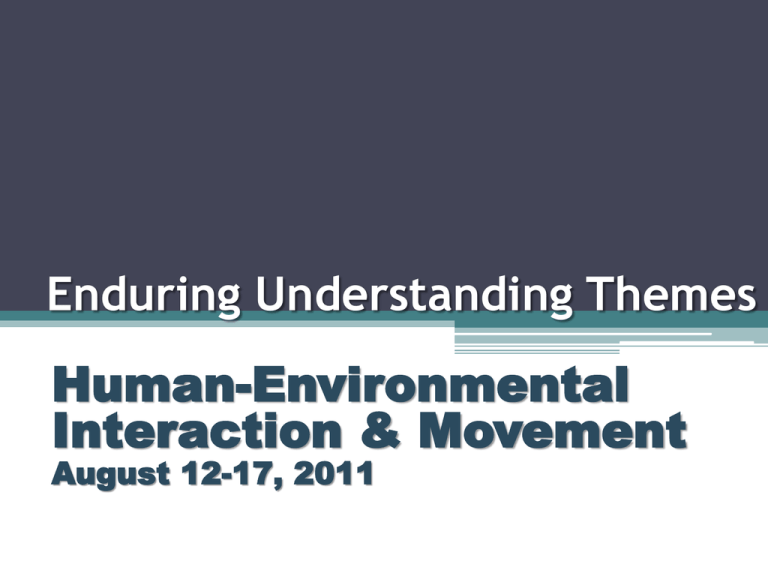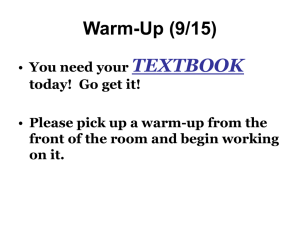Enduring Understanding Theme
advertisement

Enduring Understanding Themes Human-Environmental Interaction & Movement August 12-17, 2011 First Five Agenda Message: Five (5) E.Q.’s for the week are due today. No homework. Enjoy your weekend. E.Q. for Friday; August 12th Name two things you learned this week regarding Locations & Maps. Warm-Up Review five (5) vocabulary words with your Study Buddy. First Five Agenda Message: Pop-Quiz tomorrow on Map coordinates (latitude and longitude). E. Q. for Monday; August 15th What does human-environmental interaction mean? Warm-Up Name three ways that you can think of where humans have changed the natural environment in and around Atlanta. Human-Environment Interaction E. Q. Answer The ways in which people use, change, or live with their environment. Positive changes - makes the environment safer or more livable; Negative changes – pollutes the environment and destroys it’s natural beauty. Place and Region Place Place includes the physical features and cultural characteristics of a location. It answers the question “What is it like?” All places on earth have physical features that set them apart, such as climate, landforms, and vegetation. Think About This! How would you describe what the Atlanta area is like? Place and Region Place cont. Other features are the product of human interacting with the environment, such as by building dams, highways, or houses. Region A region is an area of the earth’s surface with similar characteristics. It answers the question “How are places similar or different?” Human-Environment Interaction The question “How do people relate to the physical world?” refers to the relationship between humans and their environment. People learn to use what the environment offers them and to change that environment to meet their needs. They also learn to live with aspects of the environment that they cannot control, such as climate. Human-Environment Interaction People living in similar environments do not respond to them in the same way. (For example some view a hot sunny climate near a body of water as ideal for recreational activities. Others may see it as an opportunity for raising citrus fruits, olives, or grapes.) Human-Environment Interaction Human beings work to alter their environments to make places better or to provide needed goods. People may drain swamps or dig irrigation ditches to grow crops in a particular environment. Sometimes the alterations create new problems, such as pollution. Human-Environment Interaction As you study geography, you will learn about many ways humans interact with their environment. Summary 1. Human-Environmental Interaction is the ways in which people use, change, or live with their environment. 2. These interactions can be positive - making places safer or more livable or they can be negative – polluting, and destroying natural beauty. Human-Environment Interaction Vocabulary Words Place Region Human-Environmental Interaction First Five Agenda Message: Vocabulary Quiz II is Friday, August 19th. Improve your quiz grade and Mr. Smith will give you the highest score for quiz 1 & 2. E. Q. for Tuesday; August 16th What does the geographic term “movement” refer to and how do geographers analyze it? Warm-Up List some examples of positive and negative effects of people altering their environments? First Five Agenda Message for 8/17/11: Vocabulary Quiz II is Friday, August 19th. There are 21 vocabulary words, 18 from last week and 3 for this week. E. Q. for Wednesday; August 17th How does Location, Human Environmental Interaction, and Movement interact? Warm-Up Name two products you have that came from another part of the world. Movement E. Q. Answer for Tuesday, August 16th Movement describes how people, ideas, and products move from one location to another. They are measured by geographers by looking at three types of distances: linear, time, and psychological distances. Movement E. Q. Answer for August 17th Where people live is effected by their location, in turn people interact with the environment for their needs, finally ideas, goods, and people move from one location to another. Movement The question “How do people, goods and ideas move from one location to another?” Refers to movement. Think about the clothing you wear, the music you listen to, or the place you go to for entertainment. All of these things involve movement from one place to another. Movement Geographers analyze movement by looking at three types of distance: 1. Linear distance 2. Time distance, and 3. Psychological distance Movement Linear Distance & Time Distance Linear distance simply means how far across the earth a person, an idea, or a product travels. Physical geography can affect linear distance by forcing a shift in a route to avoid impassable land or water. Movement Time distance is the amount of time it takes for a person, an idea, or a product to travel. Modern inventions have shortened time distances. Can you think of some examples? Movement Psychological Distance Psychological Distance refers to the way people view distance. (For instance, when you were younger, some locations seemed very far away. As you have grown older, the distance to these locations probably seemed to shrink.) Movement Summary 1. Movement describes how people, ideas, and products move from one location to another. 2. They are measured by geographers by looking at three types of distances: linear, time, and psychological distances. Vocabulary Words Movement Linear distance Time distance Psychological distance Movement Agenda Message: Vocabulary Quiz II is tomorrow, Friday. Social Studies Pre-Test is Monday, August 22nd. E. Q. for Thursday; August 18, 2011: Refer to a map of the Middle East. Describe it’s Relative Location. Warm-Up: Name the first three Enduring Understandings for 7th grade Social Science. (refer to wall posters) Movement E. Q. Answer for Thursday; August 18th The relative location for the Middle East 1. 2. 3. 4. East of the Red Sea The eastern edge of the Mediterranean Sea Northwest of the Arabian Sea Surrounds the Persian Gulf






